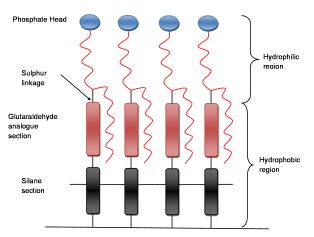Postdoctoral Research

Lysophosphatidic acid (LPA) has been found to promote osteoblast differentiation, particularly when in conjunction with vitamin D3. This may be used to promote osseointegration of titanium implants by coating the surface with LPA prior to implantation.
Titanium disks were used and ground to #80 grit. The disks were then placed in 10M sodium hydroxide and incubated at 60oC for 24 hours. The disks were then incubated for a further 1 hour at 80oC in ultrapure water, rinsed, thoroughly dried and used for silane coating within 24 hours.

The disks were treated with either vinyltrimethoxysilane, octanedithiol and LPA or (3-Mercaptopropyl)trimethoxysilane and LPA. For each the NaOH prepared disks were reacted with the silane in toluene for 24 hours at room temperature. The subsequent stages are carried out under UV irradiation for 6 hours in ultrapure water. The disks are treated with 50ÁMol LPA in 1mL ultrapure water in a glass cell plate (custom made) under UV irradiation for 6 hours. The thiol reacts with the double bond in the LPA alkene tail. The disks were rinsed and stored in ultrapure water.
Many of the methods for detecting LPA require the free acid to be available for analysis. Other methods, such as LPA ELISA kit and XPS, are available but are expensive and not suitable for regular 'quick' testing of samples.
The easiest method found to determine quantity of LPA was the use of ammonium molybdate to detect orthophosphate that has been enzymatically liberated from the molecule. Previous publications indicate the liberation of orthophosphate using alkaline phosphatase, but this creates a false positive with the acidic molybdate solution. Therefore I was investigating using acid phosphatase to determine concentration of bound LPA.
UoB home | Home | Work Homepage | PhD research | Dental Postdoc | Sonic Probe Postdoc